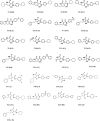Lead generation of UPPS inhibitors targeting MRSA: Using 3D-QSAR pharmacophore modeling, virtual screening, molecular docking, and molecular dynamic simulations
- PMID: 38245752
- PMCID: PMC10800075
- DOI: 10.1186/s13065-023-01110-1
Lead generation of UPPS inhibitors targeting MRSA: Using 3D-QSAR pharmacophore modeling, virtual screening, molecular docking, and molecular dynamic simulations
Abstract
Undecaprenyl Pyrophosphate Synthase (UPPS) is a vital target enzyme in the early stages of bacterial cell wall biosynthesis. UPPS inhibitors have antibacterial activity against resistant strains such as MRSA and VRE. In this study, we used several consecutive computer-based protocols to identify novel UPPS inhibitors. The 3D QSAR pharmacophore model generation (HypoGen algorithm) protocol was used to generate a valid predictive pharmacophore model using a set of UPPS inhibitors with known reported activity. The developed model consists of four pharmacophoric features: one hydrogen bond acceptor, two hydrophobic, and one aromatic ring. It had a correlation coefficient of 0.86 and a null cost difference of 191.39, reflecting its high predictive power. Hypo1 was proven to be statistically significant using Fischer's randomization at a 95% confidence level. The validated pharmacophore model was used for the virtual screening of several databases. The resulting hits were filtered using SMART and Lipinski filters. The hits were docked into the binding site of the UPPS protein, affording 70 hits with higher docking affinities than the reference compound (6TC, - 21.17 kcal/mol). The top five hits were selected through extensive docking analysis and visual inspection based on docking affinities, fit values, and key residue interactions with the UPPS receptor. Moreover, molecular dynamic simulations of the top hits were performed to confirm the stability of the protein-ligand complexes, yielding five promising novel UPPS inhibitors.
Keywords: 3D QSAR pharmacophore; Antibacterial; Bacterial resistance; Drug repurposing; Dynamic simulations; HypoGen algorithm; Methicillin-resistant Staphylococcus aureus; Molecular docking; UPPS.
© 2024. The Author(s).
Conflict of interest statement
The authors declare that there are no conflicts of interest.
Figures












Similar articles
-
Lead generation of cysteine based mesenchymal epithelial transition (c-Met) kinase inhibitors: Using structure-based scaffold hopping, 3D-QSAR pharmacophore modeling, virtual screening, molecular docking, and molecular dynamics simulation.Comput Biol Med. 2022 Jul;146:105526. doi: 10.1016/j.compbiomed.2022.105526. Epub 2022 Apr 20. Comput Biol Med. 2022. PMID: 35487125
-
3D-QSAR pharmacophore modeling, virtual screening, molecular docking, MD simulations, in vitro and in vivo studies to identify potential anti-hyperplasia drugs.Biotechnol J. 2024 Feb;19(2):e2300437. doi: 10.1002/biot.202300437. Biotechnol J. 2024. PMID: 38403464
-
Anthranilic Acid Inhibitors of Undecaprenyl Pyrophosphate Synthase (UppS), an Essential Enzyme for Bacterial Cell Wall Biosynthesis.Front Microbiol. 2019 Jan 14;9:3322. doi: 10.3389/fmicb.2018.03322. eCollection 2018. Front Microbiol. 2019. PMID: 30692977 Free PMC article.
-
3D QSAR pharmacophore, CoMFA and CoMSIA based design and docking studies on phenyl alkyl ketones as inhibitors of phosphodiesterase 4.Med Chem. 2012 Sep;8(5):894-912. doi: 10.2174/157340612802084298. Med Chem. 2012. PMID: 22741782
-
Identification of Potent Small-Molecule PCSK9 Inhibitors Based on Quantitative Structure-Activity Relationship, Pharmacophore Modeling, and Molecular Docking Procedure.Curr Probl Cardiol. 2023 Jun;48(6):101660. doi: 10.1016/j.cpcardiol.2023.101660. Epub 2023 Feb 24. Curr Probl Cardiol. 2023. PMID: 36841313 Review.
Cited by
-
Ligand-based discovery of novel N-arylpyrrole derivatives as broad-spectrum antimicrobial agents with antibiofilm and anti-virulence activity.J Enzyme Inhib Med Chem. 2025 Dec;40(1):2523970. doi: 10.1080/14756366.2025.2523970. Epub 2025 Jul 8. J Enzyme Inhib Med Chem. 2025. PMID: 40626382 Free PMC article.
-
In Silico Approach for Antibacterial Discovery: PTML Modeling of Virtual Multi-Strain Inhibitors Against Staphylococcus aureus.Pharmaceuticals (Basel). 2025 Jan 31;18(2):196. doi: 10.3390/ph18020196. Pharmaceuticals (Basel). 2025. PMID: 40006010 Free PMC article.
References
-
- Sit PS, Teh CS, Idris N, Sam IC, Syed Omar SF, Sulaiman H, et al. Prevalence of methicillin-resistant Staphylococcus aureus (MRSA) infection and the molecular characteristics of MRSA bacteraemia over a two-year period in a tertiary teaching hospital in Malaysia. BMC Infect Dis. 2017;17(1):274. doi: 10.1186/s12879-017-2384-y. - DOI - PMC - PubMed
LinkOut - more resources
Full Text Sources
